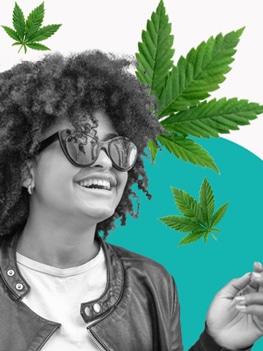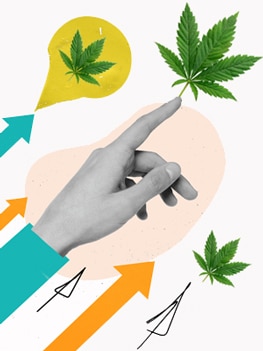Who’s Really Buying Cannabis in 2025? (Spoiler: It’s Not Who You Think)
- July 21, 2025
- Jen Lamboy
- Cannabis Industry, Marketing
Women now outpace men in cannabis consumption, Gen Z is trading alcohol for THC, and seniors are embracing the plant for discomfort and sleep.
The days of marketing to “the cannabis consumer” like they’re an unchanging monolith are over. The 2025 weed economy isn’t driven by tie-dye nostalgia or bro science anymore. Instead, it’s being reshaped by four explosive shifts:
- Women are consuming more cannabis than men for the first time.
- Millennials still spend the most, but they want function, not flash.
- Gen Z is ditching alcohol and redefining how (and why) weed is consumed.
- Seniors are quietly becoming one of the fastest-growing user groups.
If you’re still building your campaigns around old assumptions—“Boomers want nostalgia,” “men are the majority,” “Gen Z is all vapes”—you’re out of touch and you’re probably burning money in fruitless campaigns.
Let’s break it down.
Why Women Are Cannabis's Fastest-Growing Market Segment
Let’s kill the myth that women are some niche, “emerging” cannabis audience. That moment passed.
According to “Monitoring the Future” data reported by Forbes, women aged 19–30 consumed more cannabis than men for the first time in 2023. That’s what we would call a market reset. And it most certainly isn’t limited to young women.
We’re talking medical patients, working moms, wellness seekers, retired grandmothers, etc. Instead of the old cliche that women only dabble here and there, they’re actually driving entire product categories.

What's Actually Drawing Women to Cannabis?
- Stress is off the charts. Between work, parenting, caregiving, and trying to survive this era of burnout, women aren’t looking to get stoned. They’re looking to come down.
- Sleep is a crisis. Late-night doomscrolling and hormone-driven insomnia are leading more women to turn to gummies, tinctures, and CBD-heavy blends to finally rest.
- Booze is out. The “wine mom” era is fading. Women are leading the Cali sober movement, swapping chardonnay for 5mg of THC that won’t leave them hungover or bloated.
- It’s a ritual, not a rebellion. Women aren’t trying to relive the rebellious weed highs of the ‘70s. They’re looking for balance, clarity, control, and cannabis that fits into their daily routine.
So, if your brand still treats women as an afterthought or slaps pink on a preroll and calls it innovation, it’s embarrassingly outdated.
Millennials Are Still the Biggest Cannabis Spenders (And Here's Why)
Gen Z might be louder (and deeply inscrutable), but Millennials are still holding the bag. The one that’s full of dispensary receipts.
Millennials (born 1981–1996) remain the top-spending cannabis demographic in 2025. According to Flowhub and Headset data, Millennials consistently account for the largest share of legal cannabis purchases across formats and product types.
So why are they still the financial backbone of the industry?

- They’re in their peak earning years. Mid-30s to mid-40s means steady income and more fluid spending habits.
- They’re loyal. When Millennials find a brand that works, they stick with it.
- They’re pragmatic. Wellness and lifestyle matter, but so does getting bang for their buck.
One thing Millennials aren’t chasing is the highest THC punch. They want control, consistency, and clarity in their products of choice. Also, let’s be real, they’re tired. Between parenting, work, inflation, life’s daily absurdities, and a never-ending black parade of macabre historical events, Millennials care more about getting through than getting high.
Preferred formats:
- Edibles that actually taste good
- Low-dose beverages that don’t mimic frat house energy drinks
- Topicals and tinctures for chronic pain, anxiety, or burnout
If your marketing talks to Millennials like they’re wide-eyed newbies, you’ve missed the shift. Rather than curious first-timers, they’re savvy shoppers who want products that work without having to consult a gatekeeping budtender.
Gen Z Is Ditching Alcohol for Weed and the Numbers Prove It
If Millennials normalized cannabis, Gen Z made it as ubiquitous as booze was to Boomers.
Gen Z (born 1997–2012) doesn’t see cannabis as countercultural or a rebellious path for ne’er-do-wells. To them, it’s a practical and safe space. According to Headset data reported by Flowhub, Gen Z is now the fastest-growing cohort in legal cannabis sales, with many in the group already integrating cannabis into their daily lives. What’s more, a 2024 CBS News survey found that among people age 18–24, 69% prefer our favorite plant to alcohol.

The Real Reasons Gen Z Chooses Cannabis Over Cocktails

Further evidence that comes from New Frontier Data says that 56% of 18–24-year-olds reported replacing alcohol with cannabis. But why the shift? Here’s some breadcrumbs:
- They’re anxious. Gen Z lives in a constant state of economic, social, and existential tension. Cannabis is a pressure valve, not a party drug.
- Alcohol feels outdated. They’ve watched alcohol wreck older generations. Weed is seen as safer, cleaner, and way more manageable.
- They want control. Microdosing is more of a preference than trend. They want to feel something, not everything.
- They live online. A stoned selfie is chill. A drunk one? The epitome of cringe. Cannabis fits the curated reality of TikTok, Instagram, and beyond.
They’re also way more experimental than other age groups. They’ll try the new gummy, the weird new flavor, the strange new cannabinoid. But don’t expect brand loyalty. If your vibe feels fake, they’re gone.
For brands, this means:
- Kill the corporate speak
- Stop trying to be cool
- Get real or get ignored
Gen Z doesn’t want to be marketed to. They want to see themselves reflected honestly, creatively, and without pandering.
Plot Twist: Your Grandparents Are Getting High Too
Forget the stereotypes. Seniors aren’t timid about weed. They’re walking in with bad joints, strong opinions, and a soft spot for softgels.
According to recent data, cannabis consumption among adults aged 65 and older has jumped by nearly 46% in just two years, rising from 4.8% in 2021 to 7% in 2023. This demonstrates a real shift in how older Americans manage pain, sleep, and aging without leaning so hard on prescriptions. But they don’t want to feel high. They want to feel better.

Why Seniors Are Embracing Cannabis (and What They Want)
- Chronic pain is constant. Arthritis, back issues, nerve pain. For these ailments, most traditional meds come with brutal side effects. Cannabis offers relief without the gut rot.
- They want sleep. Seniors are desperate for quality rest. Low-dose THC and CBD blends are helping them get it without dependency on prescription sedatives.
- They’re replacing pharmaceuticals. From anxiety meds to opioids, older consumers are seeking more natural ways to feel better. Cannabis is on the shortlist.
This is a demographic that:
- Doesn’t trust brands that look like candy
- Won’t touch anything labeled “party”
- Reads the back of the label more than the front
So give them:
- Low-dose capsules and softgels they can take like vitamins
- Tinctures with droppers and clear instructions
- Topicals that don’t smell like bong water
And don’t assume they’re clueless. Seniors aren’t afraid of cannabis. They’re afraid of looking stupid or getting the dosage wrong. Meet them with respect, clarity, and products that make them feel in control.
How to Market to These Four Very Different Groups
One plant, four wildly different audiences. Here’s how to connect with each demographic:
Gen Z
- Speak their language. Short-form video, memes, and brutally honest content.
- Forget brand loyalty. Win them over with vibe, not heritage.
- Create for curiosity. They want experiences. That means new cannabinoids, bold flavors, and social consumption.
Marketing play: TikTok-driven storytelling, pop-up collabs with lifestyle brands, influencer UGC that doesn’t feel like an ad.
Millennials
- Lead with purpose. This group spends with intention and loves a values-driven brand.
- Focus on wellness. They’re not chasing a high. They want relief, ritual, and convenience.
- Make life easier. Clear dosing, sleek packaging, and multi-function products hit the mark.
Marketing play: Email newsletters with product education, loyalty programs that reward consistency, and in-store experiences that feel elevated and not hokey.
Women
- Segment by need-state. Don’t talk to all women the same way. A working mom and a college student are shopping for very different reasons.
- Address real-life use cases. Stress after a long day. Insomnia. Alcohol replacement. Pain relief.
- Representation matters. If your branding still screams “dude culture,” you’re invisible.
Marketing play: Collaborate with creators in fitness, parenting, wellness, and recovery communities. Build campaigns around lifestyle without watering down the message.
Seniors
- Keep it simple. No neon branding. No slang. Just helpful, respectful design.
- Education is everything. Clear dosage guides, support staff who know how to talk to them, and content that doesn’t assume prior cannabis knowledge.
- Trust is the currency. Medical alignment, consistent effects, and professional packaging all matter.
Marketing play: In-store demos, pharmacist-led events, print-friendly educational guides, and partnerships with healthcare professionals.
What Each Generation Wants from Their Cannabis
Different groups shop for different reasons. Here’s what matters most to each, and the products they tend to reach for:
Generation | What They’re Looking For | Preferred Products |
Gen Z | Novelty, social appeal, and something to take the edge off | Vapes, edibles, infused beverages |
Millennials | Practical wellness, daily support, and alignment with personal values | Edibles, topicals, low-dose flower |
Women | Relief, routine, and a reliable alcohol substitute | Microdose gummies, CBD blends, tinctures |
Seniors | Pain reduction, better sleep, and straightforward guidance | Capsules, softgels, topicals, 1:1 tinctures |
Where Cannabis Marketing Is Headed (Hint: Think Female-First)
We’ve done the research and followed the data. We’ve listened to buyers, budtenders, brand leads, and everyday consumers. When you look at the full picture, from the numbers to the trends to the firsthand stories, it all points in one direction. Cannabis marketing in 2025 needs to start with women.
This doesn’t mean slapping a softer color palette on your label or launching a “for her” product line. It means building your entire approach around what women want from cannabis and how they’re already consuming it.
Here’s what that looks like:

- Lead with needs, not noise. Sleep, stress, pain, focus, recovery. These are real concerns, not trends. Frame your messaging around real-life use, not just vibes.
- Educate instead of assuming. Many of the women buying cannabis today didn’t grow up with it. They’re smart, curious, and cautious. Give them clear info, real guidance, and zero condescension.
- Design like it matters. Good packaging doesn’t have to be feminine. It has to be readable, trustworthy, and easy to navigate. Less clutter, more clarity.
- Make the experience easier. Whether they’re juggling kids, caregiving, chronic pain, or just long days, most female consumers are short on time and patience. The path from curiosity to purchase should feel smooth, not stressful.
- Tap into real trust networks. Women are more likely to try a product recommended by someone they know. Peer reviews, creator content, and honest storytelling outperform generic ads every time.
With everything we’ve seen in the numbers and everything we’ve heard on the ground, the future of cannabis marketing isn’t a mystery. All signs point in the same direction. Build for real people, build for actual needs, and above all, start by putting women first.
Ready to rethink your strategy around real cannabis consumers?
-
 Jen Lamboy
Jen Lamboy
- Jen is Hybrid Marketing Co's Director of Strategy. She entered cannabis through seed genetics and has passionately worked to help grow the industry into a global game-changer ever since. As a strategist focused on business outcomes, Jen has worked in numerous highly-regulated industries with B2B and B2C organizations. She doesn't step lightly; she charges but with a collaborative spirit, intention, intelligence, humility, compassion, and grit.













